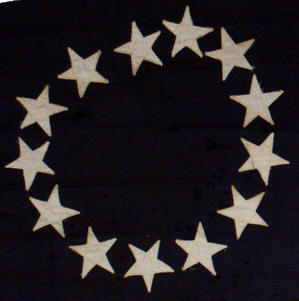
|
The Betsy Ross Pattern.
The pattern of 13 stars
arranged in a circle is
attributed through folklore
to Betsy Ross, although no
period historical evidence
links her to the design of
such a flag. The
legend of Betsy Ross began
at the time of the
Centennial of 1876 when
descendents recounted verbal
family history attributing
her as the designer and
creator of the first
American flag. This
small sewn
flag dates to
the early
20th century, as evidence by
faint writing on its hoist,
"Flag of Pa Estabrook's
Boat Florida Capt Chas
Estabrook 1904-1932".
The irregularity of the
circle, evidence that the
maker originally misjudged
the arc and then adjusted
the curve, is unique and
adds a charming
human touch to the flag. |
 |
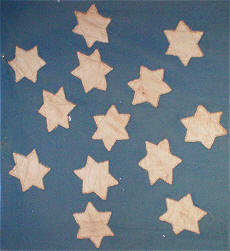
|
Snowflake.
This magnificent star
pattern for a 13 star flag
is exceptionally rare.
Examples of the pattern are
known on a handful of
surviving small printed
parade flags which date to
the Civil War era. But the
pattern's presence on a sewn
flag of the era, as seen on
this flag, is unique among
known examples. The
beautiful star pattern, in
conjunction with the
extremely rare six pointed
stars, make this flag one of
the finest 13 star early
American flags known. Click
here for to read more
about this flag. |
 |
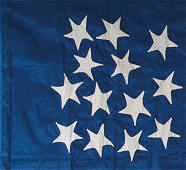
|
Scattered.
Scattered stars on a flag
are captivating and
extremely unusual.
This breathtakingly
beautiful masterpiece flag
most likely pre-dates the
American Civil War.
Though not yet positively
dated, the alignment of
stars to the right of the
canton seems to indicate the
maker was anticipating the
need to add additional
stars, an intriguing
proposition that might hint
at an earlier, possibly 18th
century, origin. Click
here to read more about
this flag. |
 |
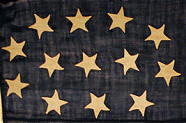
|
Oval With Three Central
Stars.
This is one of the rarest
patterns of 13 Star flags,
and may be unique.
This particular example
dates to the period between,
and inclusive of, the
Mexican War and Civil War.
Click
here to read more about
this flag. |
 |
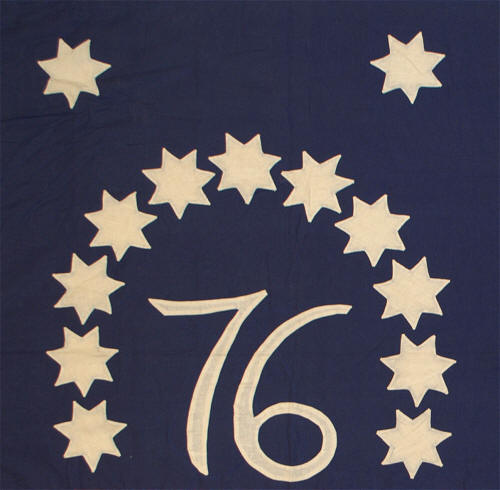
|
Bennington Pattern.
This pattern is based on a
unique 19th century example
of the American Flag known
as the Bennington Flag.
Purportedly from the
American Revolution, but
most likely either from the
early 19th century (circa
the War of 1812) or even as
late as the Centennial in
1876, the pattern has become
iconic in American culture.
This superb example is a
very rare entirely hand sewn
homemade flag from the
American Bicentennial in
1976. |
 |
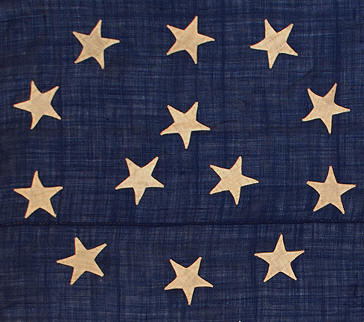
|
Circle With Three Central
Stars. Like the oval
with three central stars
above, the pattern of a
circle with three center
stars is very rare, with
just a handful of flags,
likely less than five, known
in this pattern. This
particular example is
entirely hand sewn and dates
to the period of the
American Civil War. |
 |
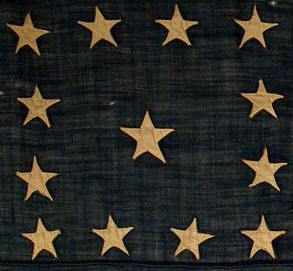
|
Trumbull Pattern. The pattern of 12 stars
arranged in a square, with a
single center star, is known
as the Trumbull pattern
after Revolutionary War
patriot and artist John
Trumbull, who painted this
configuration of stars in at
least three of his works:
The Battle of Princeton
(1777), The Surrender of
General Burgoyne at
Saratoga, New York (1777)
and The Surrender of Lord
Cornwallis at Yorktown,
Virginia, (1781). It
is one of the rarest
configurations of stars on
antique American flags.
Click
here for more
information about this
particular flag. |
 |
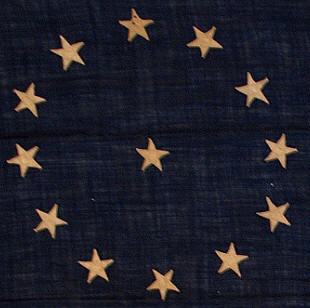
|
Cowpens or 3rd Maryland
Pattern.
This version of the flag was
reportedly carried by
William Batchelor of the 3rd
Maryland Regiment at the
Battle of Cowpens, on
January 17, 1781. The
original flag, known as the
Batchelor Flag, is currently
held in the Maryland
archives. It has since been
dated to circa 1840 or
later, but the pattern was
known to have been used
during the Revolutionary
period based on paintings
and drawings from that time. Regardless of a
possible false attribution,
the pattern is still known
as the Cowpens or 3rd
Maryland Pattern, and
encompasses flags where
a wreath of 12 stars is either
in a circle, as in this
example, or in an oval. |
 |
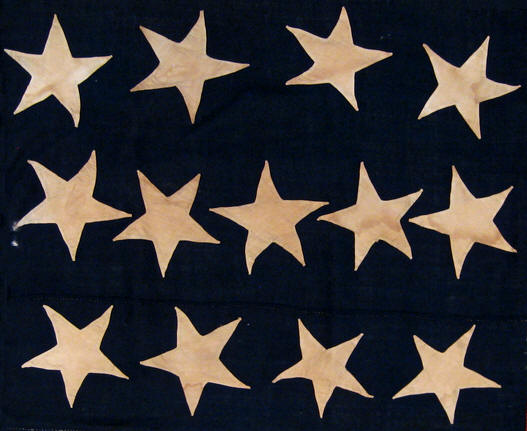
|
4-5-4 Pattern. The
4-5-4 pattern, like the
3-2-3-2-3 pattern, is known
to have been produced in the
18th century. Although
not as common as the
3-2-3-2-3, it also remained
in use for over 100 years
and can be found on examples
as late as the 1890s.
It is rarely found on flags
of the 20th century.
This fantastic flag is
entirely hand-sewn at the
firm of Leighton and Pollard
of Boston, circa 1870.
One can easily imagine this
magnificent flag hanging
from the mast of a clipper
ship or American naval
vessel. |
 |
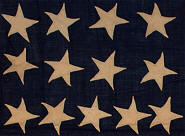 |
4-4-5 Pattern.
This very rare pattern is
known to exist on just two
early American flags.
The beautiful large stars
fill the canton of this
mid-19th century example.
The flag is entirely hand
sewn, with construction
traits very similar to the
4-5-4 flag made by Leighton
and Pollard above, circa
1870. |
 |
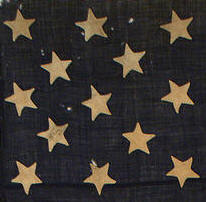
|
3-2-3-2-3 Pattern, or
Francis Hopkinson Pattern.
Although there is some
intrigue and controversy
surrounding the history of
Francis Hopkinson's submission
of designs to the
Continental Congress, which
included design of the first
Great Seal and a
representation of the
American Flag, the 3-2-3-2-3
pattern of stars is also
known to collectors as the
Francis Hopkinson Pattern.
The 3-2-3-2-3 pattern is one
of the most common
variations of 13 Star flags.
In fact, when it comes to
antique stars and stripes,
it is much more common than
the Betsy Ross
configuration, which in
reality is quite scarce. |
 |
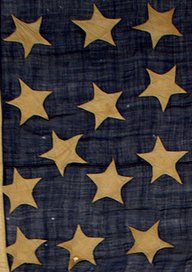
|
Scattered.
The canton of this beautiful
19th century thirteen star
flag is features a unique
and unusual random pattern
of stars. The pattern
approximates to be a rare
3-3-3-3 pattern with a final
thirteenth star added to
complete the flag. A
rare trait is that the flag
is actually longer on its
hoist than it is along the
fly. Its nearly square
proportions and narrow, tall
canton are very unusual and
wonderfully folky.
Such a flag is a prime
example of how collectors
can always be surprised by
the unique and unexpected. |
 |
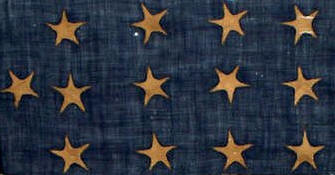
|
4-5-4 Notched Pattern.
This unusual flag of the
early 19th century likely
dates to the period circa
1820-1840. It features an
unusual notched pattern
where the 13th star appears
to be an afterthought of the
design. This rare
flag's horizontally
elongated canton and narrow
stripes are a striking
contrast to the style of the
flag directly above, with
its broad stripes and
vertically oriented canton. |
 |
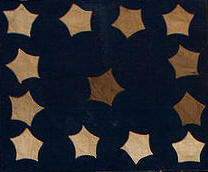
|
Trumbull Pattern.
This flag is another example
of the Trumbull pattern
named after patriot and
painter John Trumbull.
This particular flag
features bold, folky stars
that are nearly pentagonal
in shape. Based on its
construction techniques and
materials, it dates to the
first quarter of the 19th
century, and perhaps even to
the 18th century, and is one
of the oldest flags in the
Rare Flags collection. |
 |
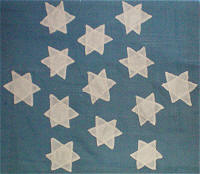 |
Six-Pointed Great Star
Pattern.
The practice of arranging 13
stars into a six-pointed
Great Star pattern in
American heraldry dates at
least as early as 1782.
The first American treaty
die of the Great Seal of the
United States featured
six-pointed stars arranged
into a large single
six-pointed Great Star. The
six-pointed Great Star
arrangement (1-4-3-4-1)
still appears above the
eagle on the official Great
Seal of the United States.
This exceptionally rare 19th
century hand sewn flag of
the features six-pointed
stars arranged into a large
six-pointed great star and
may well be unique among 13
star flags of
pieced-and-sewn
construction.
|
 |
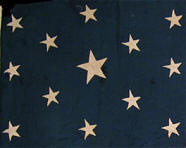
|
Hopkinson Variation.
This interesting variation
is one of many on the
3-2-3-2-3 pattern. In
this canton, the stars are
all tilted to the 11 o'clock
position, they are spaced
widely across the canton,
and a large central star
dominates the star field.
It is a beautiful and rare
variation. |
 |
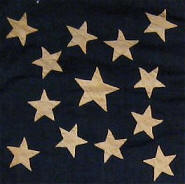
|
Medallion Pattern.
This pattern was prevalent
during the American
Centennial celebrations of
1876, although some flags of
this style date to the Civil
War or even earlier.
The pattern consists of 8
stars in a circle, a single
central star, and 1 star in
each corner of the canton. |
 |
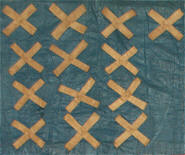
|
4-3-3-3.
This pattern, with a top row
of four stars and three rows
of three stars, is very
scarce and known on only a
handful of flags. This
particular example, where
the "X" shaped stars are
made of two crossed strips
of polished cotton fabric,
dates to the Civil War
period and is one of the
most whimsical and folky
homemade examples in the
collection. |
 |
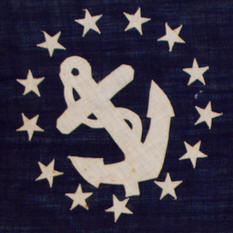
|
Yacht Ensign. The
yacht ensign consists of a
boat anchor enclosed within
a wreath of 13 stars.
The pattern first emerged in
1848 when Congress
officially designated the
design for use on
non-commercial U.S. sailing
vessels. Although the
legislation for its use was
eventually revoked, the use
of the flag persisted
throughout the late 19th and
early 20th centuries, and
continues to be widely flown
on private boats and yachts
today. This small 2' x
3' example dates circa 1920. |
 |
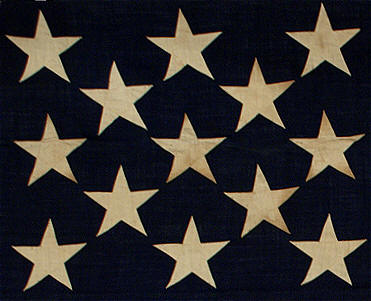
|
3-2-3-2-3 Hopkinson, Pattern,
Official U.S. Navy.
The United States Navy
continued to produce 13 star
flags in the 3-2-3-2-3
pattern well into the 20th
century. This U.S.
Navy Ensign No. 7 was
manufactured at the New York
Navy Yard in April, 1904. |
 |
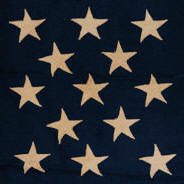
|
3-2-3-2-3 Hopkinson, Pattern,
Private Yacht Ensign.
Unlike the official U.S.
Navy example above, which is
clearly marked as a U.S.
Navy flag, this flag is an
example of a private yacht
ensign from the same period,
circa 1895-1925. Both
flags feature 13 stars
affixed with zigzag
stitching. The official Navy
flag, however, features more
traditional coloration,
tighter weave, higher
quality wool bunting and
cotton, higher quality
grommets and a more
rectangular canton.
These are all indicators of
official government
procurement, compared to the
yacht ensign which was
manufactured commercially
for private sale. |
 |
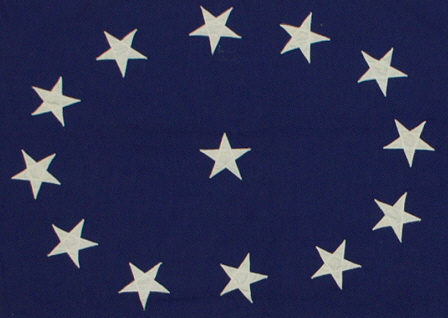
|
Oval Variation of the 3rd
Maryland Pattern.
This flag dates to the first
half of the 20th Century.
It possesses a maker's mark
on the hoist that reads "Marstin
3 x 5", indicating that the
flag is three feet on the
hoist and five feet on the
fly. Oval variations
of the 3rd Maryland Pattern
are scarce. This flag
is made of cotton and is
entirely machine stitched. |
 |
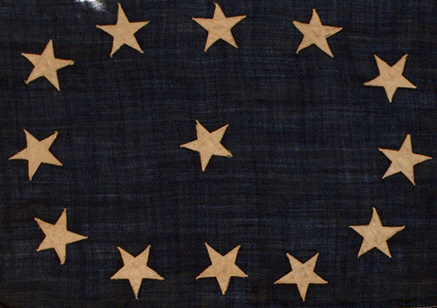 |
Oval Variation of the 3rd
Maryland Pattern.
This flag dates circa
1890-1925. The
dimensions and pattern of
this flag are similar to the
flag pictured above
(IAS-00272), but this flag
is a bit earlier, and its
canton and stripes are made
of wool rather than cotton. Oval variations
of the 3rd Maryland Pattern
are scarce. |
 |

